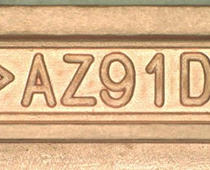Copper plating is used for printed circuit boards and other electronic device components because it excels in flexibility, electrical conductivity, and thermal conductivity. Recently, by making use of its excellent leveling and uniform electrodeposition properties, it is applied to copper plating wiring, etc., and it is also playing an active part as a nano/microfabrication technology. On the other hand, the reliability of various plating technologies is enhanced as primary plating (copper strike or electroless copper plating) to unplatable materials.
| Type of plating | Features | Characteristic value |
|---|---|---|
| Cyanide copper plating | - Tensile strength 42 – 65kg/mm2, elongation 30 – 50% - High flexibility |
- Hardness Hv100 – 160 |
| Copper sulfate plating | - Tensile strength 25 – 33kg/mm2, elongation 22 – 39% - Micro throughhole copper plating, micro via hole filling copper plating |
- Hardness Hv51 – 80 |
| Copper-based alloy plating | - Cu-Zn alloy plating: Chemical bonding with rubber without adhesive. (steel radial car tires) - Strong antimicrobial action |
|
| Copper strike (cyanide copper) plating | - Primary plating for unplatable metal materials, such as magnesium (improvement of adhesion properties) | |
| Electroless copper plating | - Primary plating for resin and ceramic materials (improvement of adhesion properties) | |

Copper plating for magnesium alloy (AZ91)